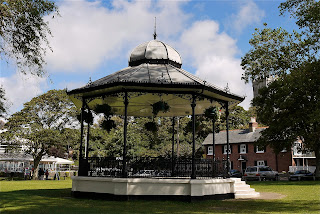The Priory
The second day of our weekend with Chris and Jill and time for a tour of Christchurch. We walked along to the Quay - where the river Stour opens out into the harbour. A very pretty sight with a large grassy area on one side of the quayside path and boast and swans on the other.
It was a commercial quay from the thirteenth century until the early 1900 but is now dominated by leisure craft.The grassy area is known as The Quomps, a name recorded from the sixteenth century, which is often historically used to denote a marshy area.
An impressive feature was the late Victorian bandstand. Apparently it is a listed building.
We passed Place Mill, which straddles the mill stream at the quay. It has medieval stonework and Tudor and eighteenth century brickwork. The mill was used for both fulling (cleaning and thickening cloth) and grinding corn until 1908. It was then used as a boatshed for 70 years before being purchased by the council and restored. Its current use is as an art gallery.
From here we passed into the Priory grounds to see the rather wonderful statue commemorating its 900th anniversary. Each face depicts activities from a different period up to the Dissolution of the Monasteries. It is the work of Jonathan Sells a self-taught mason and sculptor, based in Corfe Castle.
Now it was time for our first glimpse of the Priory. The Priory was begun in 1094 on the site of a Saxon Priory and in its initial form completed in 1150. Further major developments took place in the 13th, 14th, 15th and 16th centuries. What first caught the eye was the Norman north transept, with its arcading and Norman arches.
I was very entertained to look in Pevsner (for Hampshire) when I got home and find his comment that "The N transept is the showpiece of Christchurch".
Continuing through the Priory Gardens we came to the Perkins Mausoleum. A fear of being buried alive led Mrs Perkins to request that her body should not be interred, nor her coffin lid screwed down. Instead it was placed at the entrance to the priory's school so that the pupils would hear if she revived. When her husband died 20 years later, in 1803, her body was removed, the structure was sold and re-erected in Priory Gardens.
Nearby in the Priory gardens there was a wonderful flower garden, using annuals for an effect much like wind flowers. A far cry from the rigid formality of most park planting.
We then passed the remains of the Norman castle: a rectangular keep, built on an artificial motte (or mound).
We emerged into Castle St and passed the King's Head Hotel (which Pevsner thinks was "probably the most attractive building" to arrive a the Constable's House.
It is a domestic Norman dwelling which was built within the original castle bailey (enclosed courtyard) in 1160, earlier than the existing stone keep. It includes a rare example of a Norman Chimney (one of only five in the country according to English Heritage who now look after it).
We now crossed the very pleasant bridge over Christchurch's other river, the Avon ...
... and walked along the charming and very quiet Bridge St.
At the end, we retraced our steps to the end of Castle St and then passed the west end of the Priory, where we were struck by the extraordinary porch - "splendid" according to Pevsner - which dates from the 13th century.
We were frustrated in our desire to see the interior - not open to visitors until 2.30 on a Sunday, so we walked next along nearby Quay Road past the Red House Museum, housed in a Georgian building on 1764 which was once the town's workhouse.
We left left at the end to stumble on Sundial Cottage and soon return to the Quomps and thence to Chris and Jill's for an excellent lunch.
Conditions: warm and sunny.
Distance: about 2.5 miles.
Rating: four stars. Varied and full of interest.













No comments:
Post a Comment